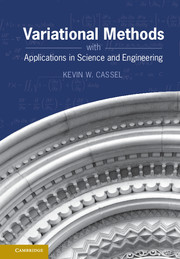4 - Hamilton's Principle
from PART II - PHYSICAL APPLICATIONS
Published online by Cambridge University Press: 05 July 2013
Summary
Nature loves simplicity and unity.
(Johannes Kepler)Calculus of variations, more than any other branch of mathematics, is intimately connected with the physical world in which we live. Nature favors extremum principles, and calculus of variations provides the mathematical framework in which to express such principles. As a result, many of the laws of physics find their most natural mathematical expression in variational form. In Chapter 1, we considered the cases of Fermat's principle of optics and minimization of total energy to determine the shape of a liquid drop on a solid surface. The objective of Part II is to provide a brief introduction to a variety of physical phenomena from a unified variational point of view. The emphasis is on illustrating the wide range of applications of the calculus of variations, and the reader is referred to dedicated texts for more complete treatments of each topic. The centerpiece of these seemingly disparate subjects is Hamilton's principle, which provides a compact form of the dynamical equations of motion – its traditional area of application – and the governing equations for many other physical phenomena as illustrated throughout this and subsequent chapters. Much of the historical development of the calculus of variations is centered around its application to dynamical systems; therefore, a number of the important principles and historical figures intimately connected with the calculus of variations will be highlighted in this chapter.
Information
- Type
- Chapter
- Information
- Variational Methods with Applications in Science and Engineering , pp. 117 - 159Publisher: Cambridge University PressPrint publication year: 2013
